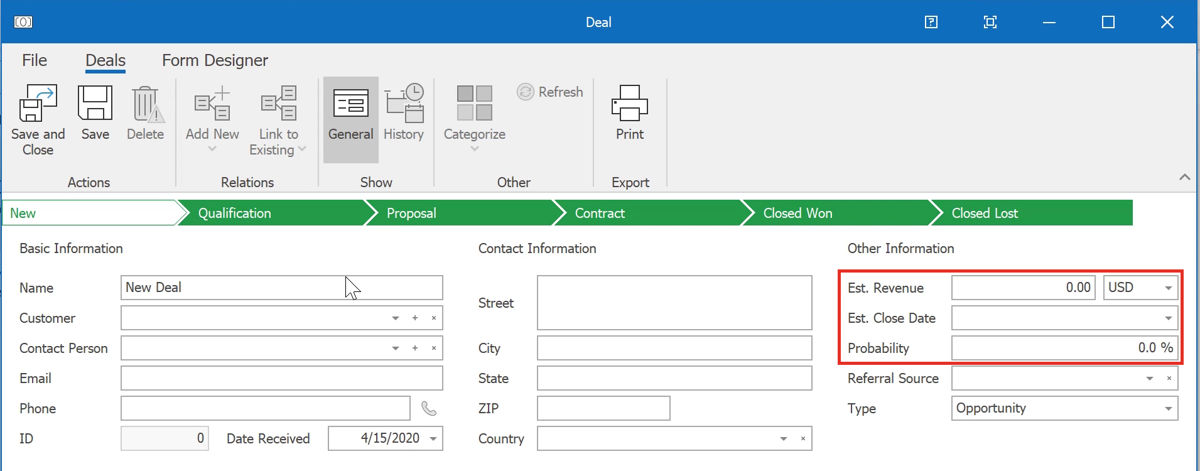
Sales forecasting is important for financial planning of companies. If, as a company, you want to grow and hire new employees, for example, you should first rely on data that support your development investment. And it is this data that is easily available to companies that use CRM.
The company's management cannot make responsible decisions, such as hiring new employees or investing in new equipment, unless they have a concrete idea of what funds they will be able to use in the coming months or years.
The cornerstone of any such decision should be, on the one hand, the most accurate company data possible and, on the other hand, external and internal factors that may affect sales. The internal ones can be, for example, hiring or departure of a new sales rep, discounts, or improvements to the range of products or services. Among the external ones, for example, there is the economic situation in the country, new competition or seasonal and other trends.
In particular, external influences can often be unpredictable, so it is safer to work with some reserves. If the company does not want to use a prophecy ball when making decisions, it must obtain the most accurate sales data. Unlike external influences, sales data can be easily measured thanks to the CRM. Whether you analyze sales from past years or months or you want to rely on an estimate of future sales of your sales reps, you will get specific numbers quickly and easily in eWay-CRM.
How to estimate revenue from business opportunities as accurately as possible
In eWay-CRM companies manage business opportunities until they win the contract. And just expected revenue from business opportunities can be the basis for forecasting future sales. In order to make the result as accurate as possible, eWay-CRM assigns information to the opportunities about the estimated value and the probability of concluding the order. To obtain an estimate of projected revenue, most companies simply select the period in which they need to quantify potential sales and, for opportunities that fall into that period, multiply the probability of closing the opportunity by its potential value.
This method, or determining the probability, can be based either on the judgment of sales reps or in eWay-CRM the setting of a specific value can be linked to the so-called automatic actions, which are based on workflow opportunities. Which method is more appropriate depends on the accuracy of the sales reps' judgment or the number of business opportunities. If there are many opportunities, automation can be beneficial.
Intuitive probability determination
If the probability of concluding a contract is determined by the sales reps themselves, they can better reflect the impression of a personal meeting or a phone call with a potential customer during the subjective evaluation. However, the disadvantage is that sales reps can sometimes be too optimistic and it is necessary to fill in and adjust the values in the long run.
An individual approach to opportunities often works for companies that process business opportunities alongside long negotiations. Let's say that a company manufactures and installs air conditioning in buildings. They probably won't have enough orders so sales reps can't pay careful attention to them individually. In eWay-CRM based on each meeting or phone call with a potential client, the sales rep can not only add a journal describing the outcome of the meeting, but also possibly adjust the probability of making a deal.
You can easily adjust the Probability of closing an order in eWay-CRM in the field of the same name in the Deals (as well as the estimated closing date and the price of the order):

Automatic adjustment of probability
The second way to set the value of the probability of closing the order is the previously mentioned automatic actions. This method is usually suitable for companies that handle a larger number of less demanding business opportunities.
A typical example of a suitable use can be a company from the food sector. Let's say that a mill processing various types of flour responds to current trends and includes new buckwheat and rice flour in its offer. Sales reps will distribute the offer of a new product to purchasing managers from retail chains or bakery owners, and they will then decide whether they are interested in the product.
However every business is really authentic. The name and number of individual phases of the workflow can be set by each company in eWay-CRM according to their needs. In practice, the probability of closing an opportunity in individual states can look like this:
- New = Probability 0%
- Qualification = 10%
- Interest = 25%
- Proposal = 50%
- Contract = 75%
- Closed Won = 100%
The probability increases (or, exceptionally, decreases) when the stage at which the business opportunity is located changes. To obtain an estimate of future sales, it is again sufficient to multiply the potential value of opportunities by their probability.
How to get a comprehensive estimate of future sales in eWay-CRM
To get an estimate of future sales in eWay-CRM, go to the Deals module and filter the opportunities with the expected end date in the required period. Therefore, you will need to have the Est. Close Date, Est. Revenue, Probability, and Est. Value columns displayed in the opportunity list (unless you have to customize the list using the Column Chooser feature).
Once you have a list of opportunities tailored and filtered as needed, below the Est. Value (Default Currency) column you'll find an overall estimate of future revenue from all opportunities in that period. Below Est. Revenue (Default Currency) column, you will see the sum of the planned final opportunity price, and below the Probability column, you will see the average probability of all opportunities. It is by multiplying the price and the probability of the opportunity that the estimate of future sales is calculated.

If you only want to count opportunities for which you have already sent an offer to a potential customer or are just waiting for the contract to be signed, right-click on the Probability column and select Group By This Column. In each row, you will now see the estimated cost of all the opportunities that are at this stage in Est. Value (Default Currency).

How to analyze data from the previous sales
Another way companies often estimate future sales is to analyze sales for a particular period in previous years, according to which they estimate sales for the same upcoming period. This can be more advantageous for companies whose offer is significantly seasonal. If we stay with the food sector, the supplier of boxes with fresh organic vegetables and fruits will certainly record significantly higher sales in June than in January.
On the other hand, some companies monitor sales from recent months and evaluate the trend in which sales are declining. This may again guide the flour supplier, as the consumption of bread is more or less the same throughout the year. However, the field in which the company operates should be stable. If sales fluctuate a lot, it is difficult to follow any trends.
The advantage of both ways of analyzing data from previous sales is that they are real sales data, albeit past ones. If a company doesn't see how sales reps evaluate opportunities, this method may be ideal. A specific advantage of eWay-CRM is integration with accounting systems like QuickBooks. The company's management do not have to buy additional licenses for accounting software, it is enough for corporate accountants (they will use the full potential of accounting software) if they want to have access to financial data.
How to get data on previous sales in eWay-CRM
You can monitor data on previous sales in eWay-CRM in the Bookkeeping module. In the Type column, filter the documents of the type Sales Invoice and in the field Due Date, filter the invoices according to the due date. Below the Price (Default Currency) column, you'll see the total revenue for the selected time period.

If you want to monitor the development of sales in recent months, filter invoices similarly, for example, from January 1 to July 31 this year. Then right-click on the Due Date column and select Group By This Column. Invoices will be grouped by date. To group by months, right-click the Due Date field again, select Group Interval, and Month. The sum of sales for each month will then be clearly arranged in individual lines.

Get enough information for important decisions
If you want to strengthen your team or invest in new equipment, thanks to eWay-CRM, you will get the data you need to estimate future sales easily and quickly.
In addition, you are still moving in the Microsoft Outlook environment, so there is no need to log in to the accounting system or collect information from merchants and copy data to Excel. All eWay-CRM modules are interconnected, and these two ways of estimating future sales are only a fraction of how working with company data in eWay-CRM will help you get the maximum information for important business management decisions.











